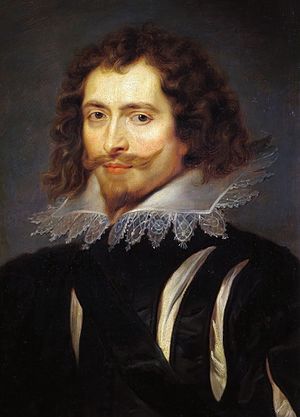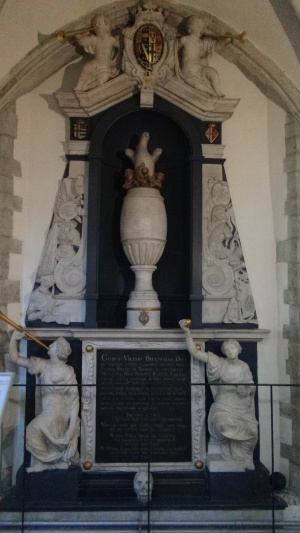Difference between revisions of "George Villiers, 1st Duke of Buckingham"
m |
(Villiers monument) |
||
| Line 7: | Line 7: | ||
Villiers took a leading role of many of the political and military events of James's reign, many of which turned out very badly, and he became very unpopular. According to some accounts he became the lover of Anne of Austria, Queen of France (whose husband, Louis XIII, is said to have been gay). | Villiers took a leading role of many of the political and military events of James's reign, many of which turned out very badly, and he became very unpopular. According to some accounts he became the lover of Anne of Austria, Queen of France (whose husband, Louis XIII, is said to have been gay). | ||
| − | After James's death in 1625 Villiers remained in favour with James's son, Charles I, but he was assassinated in [[Portsmouth]] in 1628.[[File:DSC06381.JPG|thumb|200 pxs| Monument to George Villiers, Portsmouth Cathedral]] | + | After James's death in 1625 Villiers remained in favour with James's son, Charles I, but he was assassinated in [[Portsmouth]] in 1628.[[File:DSC06381.JPG|thumb|200 pxs| Monument to George Villiers, Portsmouth Cathedral]] The magnificent monument in Portsmouth Cathedral to Villiers contains his heart and brain. The rest of the body was buried in Westminster Abbey <ref> https://hampshirearchivestrust.co.uk/stories/blog/hampshires-lgbt-history </ref>. |
==References== | ==References== | ||
Revision as of 22:36, 1 July 2023
George Villiers, 1st Duke of Buckingham (1592–1628) was a favourite, and said to be the lover, of King James I.In 1614, Villiers, then said to be "the handsomest-bodied man in England",[1] was introduced to King James, who soon developed a strong affection for him, calling him his "sweet child and wife". He was initially supported by those who opposed the King's current favourite, Robert Carr Earl of Somerset. Over the next few years he was rapidly made a knight, baron, viscount, earl, marquess, and finally duke.
Restoration of Apethorpe Hall, Northamptonshire, in 2004–2008 revealed a previously unknown passage linking Villiers' bedchamber with that of James.[2]
Villiers took a leading role of many of the political and military events of James's reign, many of which turned out very badly, and he became very unpopular. According to some accounts he became the lover of Anne of Austria, Queen of France (whose husband, Louis XIII, is said to have been gay).
After James's death in 1625 Villiers remained in favour with James's son, Charles I, but he was assassinated in Portsmouth in 1628. The magnificent monument in Portsmouth Cathedral to Villiers contains his heart and brain. The rest of the body was buried in Westminster Abbey [3].References
- ↑ Godfrey Goodman, Bishop of Gloucester, quoted in King Charles I by Pauline Gregg, University of California Press, Berkeley, 1984. isbn=9780520051461
- ↑ Fiona Graham, "To the manor bought", BBC News Magazine http://news.bbc.co.uk/1/hi/magazine/7436409.stm
- ↑ https://hampshirearchivestrust.co.uk/stories/blog/hampshires-lgbt-history

